Abstract
Objective: To characterize and analyze the inpatient and emergency pediatric dermatology consults in our academic hospital center. Methods: We reviewed 485 consultations that were done by the University of Puerto Rico Department of Dermatology from July 2007 to June 2012. The date, patient age and gender, consulting service, presumptive diagnosis, final diagnosis, and diagnostic procedures performed were documented for each consult. Results: The patients’ ages ranged from newborn to 18 years; the 13 to 18 years age group was the most common (29%). Dermatology consults were requested by the general pediatrics ward, primarily (32%), followed by the emergency room (25%). In 236 cases (48.6%), a vague diagnostic impression was provided by the consulting service, whereas in 249 (51.4%) cases, a specific or differential diagnosis was provided. The dermatology service changed the diagnosis in 12% (58/249) of the evaluated cases. The most common misdiagnoses were allergic contact dermatitis, drug eruption, papular urticaria, nutritional deficiency, atopic dermatitis, seborrheic dermatitis, cellulitis, and herpes infection. The most common diagnoses encountered were inflammatory skin conditions, infectious diseases, and drug eruptions. Skin biopsy was the most common procedure performed. In 30% of the cases, more than 1 procedure was performed as part of the evaluation work-up. Conclusion: Our study demonstrates the important role of the dermatologist in the diagnosis and management of pediatric patients with dermatological diseases. The information contained within this manuscript should contribute to raising the awareness of pediatricians regarding the most common dermatological diagnoses in this patient population.
Authors who publish with this journal agree to the following terms:
a. Authors retain copyright and grant the journal right of first publication with the work simultaneously licensed under a Creative Commons Attribution License that allows others to share the work with an acknowledgement of the work's authorship and initial publication in this journal.
b. Authors are able to enter into separate, additional contractual arrangements for the non-exclusive distribution of the journal's published version of the work (e.g., post it to an institutional repository or publish it in a book), with an acknowledgement of its initial publication in this journal.
c. Authors are permitted and encouraged to post their work online (e.g., in institutional repositories or on their website) prior to and during the submission process, as it can lead to productive exchanges, as well as earlier and greater citation of published work (See The Effect of Open Access).
